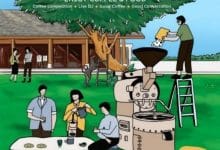Anger and tears over shooting of Dutch crime reporter Peter R. de Vries

“Your work is not finished, Peter R. de Vries. Keep fighting,” says 61-year-old Renate Tjon-Fo who is standing in front of the rows of flowers placed where Dutch crime journalist Peter R. de Vries was shot on Tuesday night.
Television crews and journalists from across the world gather outside the studio of RTL Boulevard, a popular Dutch daily television program. At the spot where de Vries was shot multiple times, including in the head, now lay flowers, handwritten messages and candles.
Tjon-Fo prays to God for de Vries’ recovery and says: “[He] has done a lot for people in society, particularly for those people who could not afford a lawyer. He was one of the most righteous people out there, and now the wrong and unjust people got to him.”
Victim of the crimes on which he reported
Peter R. de Vries is a household name for many in the Netherlands. For years, he has appeared on evening news programs and talk shows to report on high-profile criminal cases.
At the time of the shooting, de Vries was acting in an advisory role in what has become known as the Marengo trial.
The case revolves around Ridouan Taghi and 16 other co-defendants who public prosecutors in the Netherlands believe to be part of the so-called “Mocro-mafia.” As suspected members of the Moroccan-Dutch criminal syndicate, it is alleged they are responsible for a series of murders and attempted murders in the Netherlands between 2015 and 2019.
Crime reporter de Vries acted as a spokesperson and non-legal advisor for crown witness Nabil B. who is testifying against Taghi, the alleged mastermind of the Amsterdam-based group which is seen as one of the Netherlands’ largest cocaine distributors.
Two people close to Nabil B. are already dead, allegedly murdered by Taghi’s associates. In 2018, Nabil B.’s brother was murdered in broad daylight in Amsterdam and in 2019 his lawyer Derk Wiersum was gunned down outside his home.
De Vries’ work exposing the underworld has resulted in repeated death threats. Dutch newspaper De Telegraaf, where de Vries started his career, says he investigated more than 500 murders. In 2019, the journalist said he was on Taghi’s hitlist.
As de Vries fights for his life in an Amsterdam hospital, two suspects remain in custody — a 35-year-old Polish national living in the Netherlands and a 21-year-old man from Rotterdam. Both will appear in court on Friday. A third man arrested Tuesday night following the shooting has been released. A motive for the shooting has not been disclosed.
The Netherlands, a narco-state?
The shooting of de Vries is the latest in a series of violent incidents in the Netherlands, otherwise considered to be a very safe country.
In 2012, Amsterdam saw the shooting of rival gang members with Kalashnikovs. In 2016, a severed head was found outside a cafe. Last year, Dutch police discovered seven shipping containers near the port city of Rotterdam which had been converted into cells and torture chambers — one contained a dentist’s chair fitted with straps and handcuffs.
As a result of such violence, a2018 Dutch Police Union reportlikened the Netherlands to a “narcostate.” The report, which draws on the experience and expertise of Dutch detectives, stated: “If their criminal interests are in jeopardy, they do not shy away from [secretly] threatening and/or extorting influential figures such as mayors, councilors and journalists.”
A dangerous profession
Minister for Justice and Safety Ferdinand Grapperhaus says that drug criminality in the country must be stopped. At a press conference following the shooting, he praised de Vries as a “courageous and critical man.” “It hurts our society,” Grapperhaus added, calling the attack on the journalist an attack on press freedom.
“This hits journalism directly in the heart,” says Thomas Bruning, general secretary of the Netherlands Association of Journalists. The association is due to meet with Grapperhaus on Thursday to discuss threats to members of the media within the country.
Journalists from across the Netherlands and around the world are taking to social media to show support. “Journalists in the EU must be able to investigate crime and corruption without fearing for their safety,” writes Tom Gibson from the Committee to Protect Journalists.
Journalists from the De Telegraaf tabloid, where de Vries had previously worked, are outraged at the attack. Mick van Wely, a crime reporter for the newspaper weighed in, writing in Dutch: “This is too big, it has to stop,” and “keep fighting, Peter.”
Citizens laying floral tributes to de Vries are also baffled by the audacity of the attack, which happened during daylight in one of the busiest streets in the capital.
“It is a dangerous profession,” says 62-year-old Patty Heijjer with tears in her eyes. “This should not be possible here in the Netherlands.”
“It is terrible,” says Daniel Zeevaarder, a retail employee from Amsterdam who brought purple and yellow potted flowers to the place de Vries was shot. “Peter, keep holding on,” is written on one, and “if only there were more like you,” scrawled on the other.
SOURCE: DW News
Latest Thailand News
Follow The Thaiger on Google News:


























